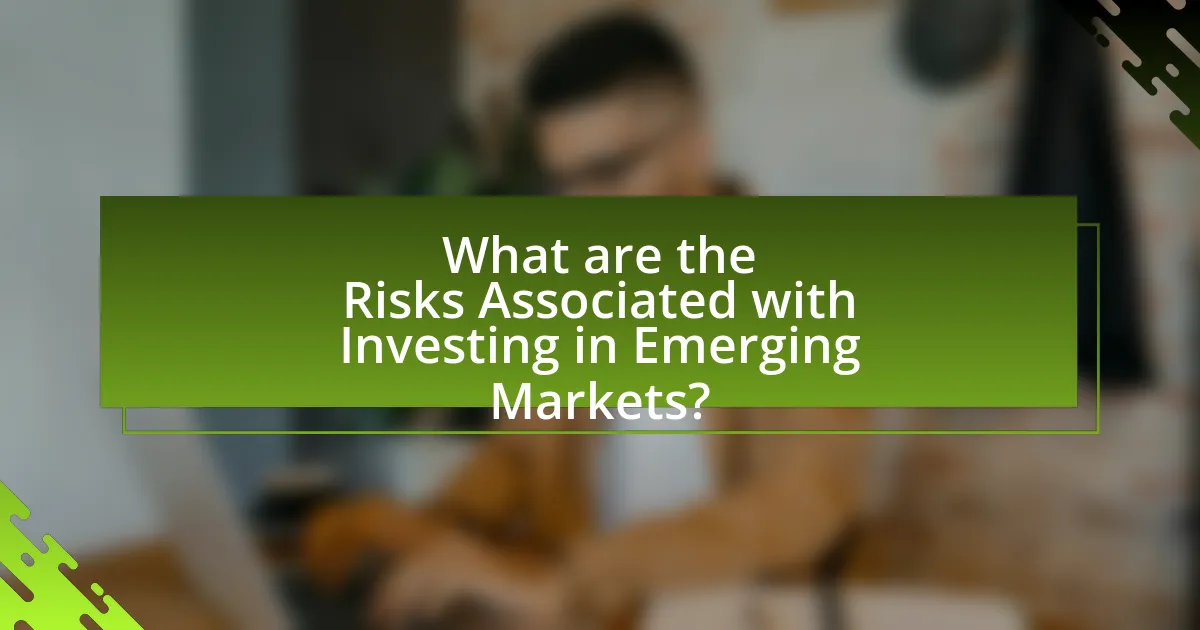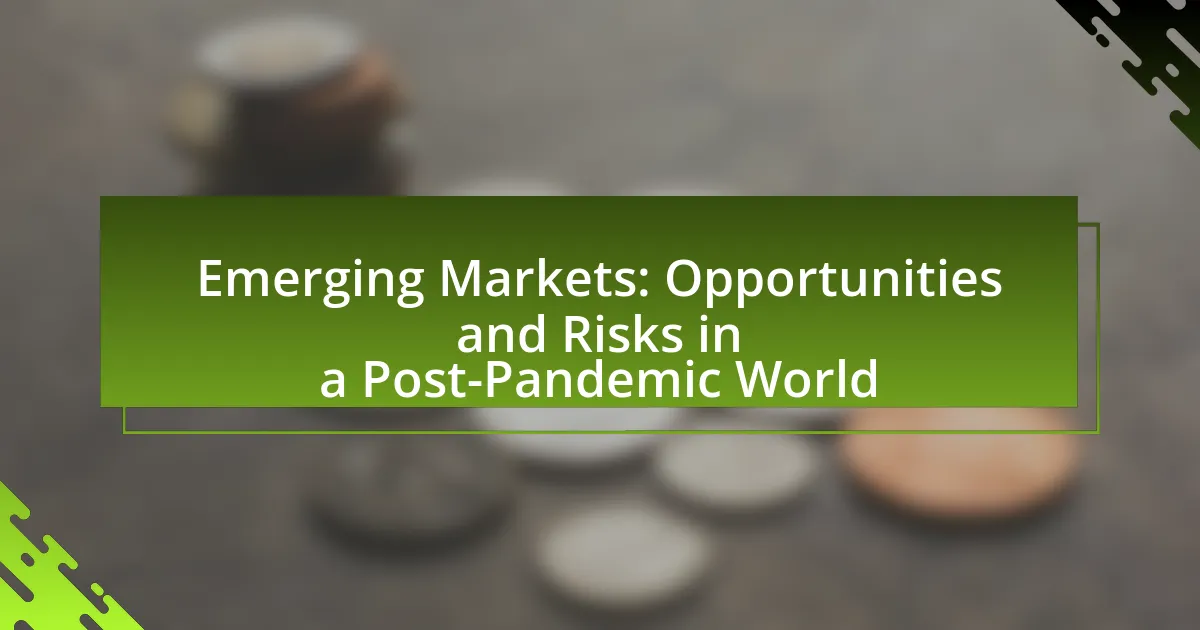Emerging markets, defined as economies transitioning from developing to more advanced status, are characterized by rapid growth, increasing industrialization, and improving infrastructure. This article examines the resilience of emerging markets such as India, Brazil, and Vietnam in the post-pandemic context, highlighting their potential for investment and development despite facing challenges like political instability, inflation, and supply chain disruptions. Key opportunities for investors in sectors like technology, healthcare, and renewable energy are discussed, along with the risks associated with currency volatility and governance issues. The article also explores future trends, including digital transformation and sustainability practices, that will shape the economic landscape of these markets.

What are Emerging Markets in a Post-Pandemic World?
Emerging markets in a post-pandemic world are economies that are transitioning from developing to more advanced economic status, characterized by rapid growth, increasing industrialization, and improving infrastructure. These markets, such as India, Brazil, and Vietnam, have shown resilience during the pandemic, with many adapting to new economic realities through digital transformation and innovation. According to the International Monetary Fund, emerging markets are projected to grow at a rate of 6.3% in 2021, outpacing advanced economies, which highlights their potential for investment and development in the post-pandemic recovery phase.
How do Emerging Markets differ from Developed Markets?
Emerging markets differ from developed markets primarily in their economic growth potential and market maturity. Emerging markets, such as India and Brazil, typically exhibit higher growth rates due to factors like a younger population and increasing industrialization, while developed markets, like the United States and Germany, have more stable economies with slower growth rates. According to the International Monetary Fund, emerging markets are projected to grow at an average rate of 4.5% annually, compared to 2% for developed markets. Additionally, emerging markets often face greater volatility and risks, including political instability and less regulatory transparency, which contrasts with the more stable and regulated environments of developed markets.
What characteristics define Emerging Markets?
Emerging markets are characterized by rapid economic growth, increasing industrialization, and improving infrastructure. These markets typically exhibit lower income levels compared to developed countries, yet they show potential for significant investment returns due to their expanding consumer bases and evolving markets. For instance, countries like India and Brazil have demonstrated substantial GDP growth rates, often exceeding 5% annually, which highlights their economic dynamism. Additionally, emerging markets often experience higher volatility in financial markets, influenced by political instability and external economic factors, making them both risky and attractive for investors seeking higher yields.
Why are Emerging Markets important for global economics?
Emerging markets are important for global economics because they represent significant growth potential and contribute to global trade dynamics. These markets, characterized by rapid economic development and increasing industrialization, accounted for approximately 60% of global GDP growth in recent years, highlighting their role as engines of economic expansion. Additionally, emerging markets often provide access to new consumer bases, with a rising middle class that drives demand for goods and services, further integrating them into the global economy. Their participation in international trade and investment flows enhances global economic stability and diversification, making them crucial players in the interconnected world economy.
What challenges do Emerging Markets face in a post-pandemic context?
Emerging markets face significant challenges in a post-pandemic context, including economic recovery, inflation, and supply chain disruptions. Economic recovery is hindered by reduced foreign investment and slower growth rates, as evidenced by the International Monetary Fund projecting that emerging economies will grow at a slower pace than advanced economies in the coming years. Inflation has surged in many emerging markets, driven by rising commodity prices and supply chain issues, which can destabilize local currencies and erode purchasing power. Additionally, supply chain disruptions continue to affect trade and manufacturing, limiting access to essential goods and increasing costs. These interconnected challenges complicate the path to stability and growth for emerging markets in the aftermath of the pandemic.
How has the pandemic impacted economic growth in Emerging Markets?
The pandemic has significantly hindered economic growth in Emerging Markets, leading to a contraction of approximately 2.1% in 2020, as reported by the International Monetary Fund. This decline was primarily due to disruptions in trade, reduced consumer spending, and increased unemployment rates. Additionally, many Emerging Markets faced challenges such as limited fiscal space and reliance on external financing, which exacerbated their economic vulnerabilities during the crisis. The World Bank noted that recovery has been uneven, with some countries experiencing slower growth rates compared to pre-pandemic levels, highlighting the long-term impacts of the pandemic on their economic trajectories.
What are the key socio-political challenges affecting these markets?
Key socio-political challenges affecting emerging markets include political instability, corruption, and social inequality. Political instability often leads to unpredictable economic environments, as seen in countries like Venezuela, where government turmoil has resulted in hyperinflation and mass emigration. Corruption undermines governance and deters foreign investment, exemplified by cases in Nigeria, where mismanagement of resources has stunted economic growth. Social inequality exacerbates tensions and can lead to civil unrest, as observed in Brazil, where disparities in wealth have sparked widespread protests. These challenges collectively hinder sustainable development and economic progress in emerging markets.
What opportunities exist for investors in Emerging Markets post-pandemic?
Investors in Emerging Markets post-pandemic have opportunities in sectors such as technology, healthcare, and renewable energy. The pandemic accelerated digital transformation, leading to increased demand for tech solutions, particularly in e-commerce and fintech, with the global fintech market projected to reach $460 billion by 2025. Additionally, healthcare investments are poised to grow as countries enhance their healthcare infrastructure, with the global healthcare market expected to exceed $11 trillion by 2027. Renewable energy is also gaining traction, driven by government initiatives and a global shift towards sustainability, with investments in renewable energy projected to reach $2.15 trillion by 2025. These sectors present significant growth potential for investors looking to capitalize on the evolving landscape in Emerging Markets.
Which sectors are poised for growth in Emerging Markets?
Technology, healthcare, and renewable energy sectors are poised for growth in Emerging Markets. The technology sector is expanding rapidly due to increased internet penetration and mobile connectivity, with the number of internet users in emerging economies projected to reach 3.6 billion by 2025. The healthcare sector is also experiencing growth driven by rising demand for medical services and pharmaceuticals, particularly as populations age and urbanize. Additionally, the renewable energy sector is gaining traction as countries aim to meet climate goals, with investments in solar and wind energy expected to increase significantly, supported by initiatives like the Paris Agreement.
How can investors capitalize on technological advancements in these markets?
Investors can capitalize on technological advancements in emerging markets by identifying sectors that are experiencing rapid digital transformation, such as fintech, e-commerce, and telehealth. For instance, the global fintech market is projected to grow at a compound annual growth rate (CAGR) of 23.58% from 2021 to 2026, driven by increased smartphone penetration and internet access in these regions. By investing in companies that leverage technology to improve financial inclusion, streamline supply chains, or enhance healthcare delivery, investors can tap into significant growth potential. Additionally, the adoption of technologies like artificial intelligence and blockchain in these markets can lead to increased efficiency and transparency, further attracting investment opportunities.

What are the Risks Associated with Investing in Emerging Markets?
Investing in emerging markets carries several risks, including political instability, currency volatility, and lack of regulatory transparency. Political instability can lead to abrupt changes in government policies, affecting investment returns; for instance, countries like Venezuela have experienced significant economic downturns due to political turmoil. Currency volatility poses a risk as fluctuations can erode returns when converting profits back to the investor’s home currency; the Argentine peso, for example, has seen dramatic depreciation in recent years. Additionally, the lack of regulatory transparency can result in unexpected legal challenges and corruption, as seen in various cases across different nations. These factors collectively contribute to a higher risk profile for investments in emerging markets compared to developed markets.
What economic risks should investors be aware of?
Investors should be aware of several economic risks, including currency volatility, political instability, inflation, and changes in global trade policies. Currency volatility can significantly impact returns, as fluctuations in exchange rates affect the value of investments in emerging markets. Political instability, often characterized by government changes or civil unrest, can disrupt markets and lead to sudden losses. Inflation poses a risk by eroding purchasing power and potentially leading to higher interest rates, which can negatively affect investment returns. Additionally, changes in global trade policies, such as tariffs or trade agreements, can alter market dynamics and impact the profitability of investments in emerging economies. These risks are particularly relevant in the context of emerging markets, where economic conditions can be more unpredictable compared to developed markets.
How do currency fluctuations impact investments in Emerging Markets?
Currency fluctuations significantly impact investments in Emerging Markets by affecting the returns on investments and the overall risk profile. When a local currency depreciates against major currencies like the US dollar, foreign investors may experience reduced returns when converting profits back to their home currency. For instance, a 10% depreciation of the Brazilian real against the dollar can lead to a 10% loss in dollar-denominated returns for investors. Conversely, if the local currency appreciates, it can enhance returns for foreign investors. Additionally, currency volatility can increase uncertainty, leading to higher risk premiums demanded by investors, which can deter investment inflows. Historical data shows that during periods of significant currency volatility, such as the 2018 Turkish lira crisis, foreign direct investment in Turkey dropped sharply, illustrating the direct correlation between currency stability and investment attractiveness in Emerging Markets.
What role does inflation play in the risk landscape?
Inflation significantly influences the risk landscape by eroding purchasing power and increasing uncertainty in economic conditions. As inflation rises, consumers face higher prices, which can lead to decreased spending and slower economic growth. For instance, in 2021, the U.S. experienced inflation rates exceeding 5%, prompting concerns about potential interest rate hikes by the Federal Reserve, which can further impact investment and borrowing costs. Additionally, in emerging markets, high inflation can destabilize currencies and lead to capital flight, as investors seek more stable environments. This dynamic illustrates how inflation acts as a critical risk factor that can affect both consumer behavior and broader economic stability.
What geopolitical risks affect Emerging Markets?
Geopolitical risks affecting Emerging Markets include political instability, trade tensions, and regional conflicts. Political instability, such as government changes or civil unrest, can disrupt economic activities and deter foreign investment, as seen in countries like Venezuela and Myanmar. Trade tensions, particularly between major economies like the U.S. and China, can lead to tariffs and reduced market access, impacting export-driven Emerging Markets. Regional conflicts, such as those in the Middle East or Eastern Europe, can create uncertainty and volatility, affecting investor confidence and economic growth. These factors collectively pose significant challenges to the stability and development of Emerging Markets.
How do political instability and governance issues influence investment decisions?
Political instability and governance issues significantly deter investment decisions by increasing perceived risks and uncertainties. Investors typically seek stable environments where the rule of law is upheld, and governance is transparent; when these conditions are lacking, as evidenced in countries experiencing civil unrest or corruption, capital flight often occurs. For instance, the World Bank reported that countries with high levels of corruption see a reduction in foreign direct investment by up to 30%. Furthermore, political instability can lead to abrupt policy changes, which disrupt market conditions and deter long-term investments. Historical examples include Venezuela, where political turmoil has led to a drastic decline in foreign investment, illustrating how governance issues directly correlate with investor confidence and economic stability.
What are the implications of trade policies on Emerging Markets?
Trade policies significantly impact Emerging Markets by influencing their economic growth, investment attractiveness, and trade balances. For instance, protectionist measures from developed countries can restrict market access for emerging economies, leading to reduced export revenues. According to the World Bank, trade policies that favor liberalization can enhance GDP growth in these markets by up to 1.5% annually, as they gain access to larger markets and attract foreign direct investment. Conversely, tariffs and quotas can hinder development by increasing costs for local businesses and consumers, ultimately stifling innovation and competitiveness. Thus, the implications of trade policies are critical in shaping the economic landscape of Emerging Markets.
How can investors mitigate risks in Emerging Markets?
Investors can mitigate risks in Emerging Markets by diversifying their portfolios across various sectors and geographies. Diversification reduces exposure to any single market or economic event, thereby lowering overall risk. For instance, a study by the International Monetary Fund indicates that diversified investment strategies can lead to more stable returns, especially in volatile environments typical of Emerging Markets. Additionally, investors should conduct thorough due diligence, including political and economic analysis, to understand the specific risks associated with each market. This approach is supported by historical data showing that informed investment decisions can significantly enhance risk-adjusted returns in these regions.
What strategies can be employed to diversify investments?
To diversify investments, investors can employ strategies such as asset allocation, sector diversification, geographic diversification, and investing in alternative assets. Asset allocation involves spreading investments across various asset classes like stocks, bonds, and cash to reduce risk; for example, a balanced portfolio might include 60% stocks and 40% bonds. Sector diversification entails investing in different sectors of the economy, such as technology, healthcare, and consumer goods, to mitigate the impact of sector-specific downturns. Geographic diversification involves investing in international markets to capture growth opportunities outside the domestic economy, which can be particularly beneficial in emerging markets that may offer higher growth potential. Lastly, investing in alternative assets like real estate, commodities, or private equity can provide additional diversification benefits, as these assets often have low correlation with traditional investments. These strategies collectively help to manage risk and enhance potential returns in a post-pandemic investment landscape.
How important is local knowledge and partnerships in risk management?
Local knowledge and partnerships are crucial in risk management, particularly in emerging markets. They provide insights into regional dynamics, cultural nuances, and specific risks that may not be apparent to external stakeholders. For instance, a study by the World Bank highlights that local partnerships can enhance the effectiveness of risk mitigation strategies by leveraging community networks and resources. This localized approach allows organizations to respond more effectively to challenges, as evidenced by successful disaster response initiatives that relied on local expertise and collaboration.

What are the Future Trends for Emerging Markets?
Future trends for emerging markets include increased digital transformation, a focus on sustainability, and enhanced regional trade agreements. Digital transformation is driven by the rapid adoption of technology, with a projected growth in internet penetration and mobile connectivity, which can boost economic activities. Sustainability trends are evident as countries prioritize green energy and sustainable practices, aligning with global climate goals. Enhanced regional trade agreements, such as the African Continental Free Trade Area, aim to reduce trade barriers and foster economic collaboration, potentially increasing intra-regional trade by 52.3% by 2022, according to the African Union. These trends indicate a shift towards more resilient and interconnected economies in emerging markets.
How will digital transformation shape Emerging Markets?
Digital transformation will significantly shape Emerging Markets by enhancing economic growth, improving access to services, and fostering innovation. As digital technologies proliferate, businesses in these markets can leverage e-commerce, mobile banking, and digital platforms to reach broader audiences and streamline operations. For instance, according to a McKinsey report, digital adoption in emerging economies could add $3.7 trillion to their GDP by 2025, highlighting the potential for substantial economic impact. Furthermore, increased internet penetration and mobile connectivity enable greater access to education and healthcare, which can improve overall quality of life and productivity. This transformation also encourages local startups and entrepreneurs to innovate, creating new job opportunities and driving competitiveness in the global market.
What role does e-commerce play in the growth of these markets?
E-commerce significantly drives the growth of emerging markets by enhancing access to global markets and facilitating consumer engagement. This digital platform allows businesses in these regions to reach a broader audience, increasing sales opportunities and fostering economic development. For instance, according to a report by the United Nations Conference on Trade and Development (UNCTAD), e-commerce in developing countries grew by 25% in 2020, highlighting its crucial role in economic resilience during the pandemic. Furthermore, e-commerce enables small and medium-sized enterprises (SMEs) to compete on a global scale, thereby contributing to job creation and innovation within these markets.
How is fintech revolutionizing financial access in Emerging Markets?
Fintech is revolutionizing financial access in Emerging Markets by providing innovative solutions that bypass traditional banking infrastructure. Mobile banking platforms, digital wallets, and peer-to-peer lending services enable individuals and small businesses to access financial services without the need for physical bank branches. For instance, according to a report by the World Bank, over 1.7 billion adults globally remain unbanked, with a significant portion residing in Emerging Markets; fintech solutions are addressing this gap by offering low-cost, accessible financial products. Additionally, the rise of blockchain technology enhances transparency and reduces transaction costs, further facilitating financial inclusion.
What environmental and social factors will influence Emerging Markets?
Environmental and social factors that will influence Emerging Markets include climate change, resource scarcity, urbanization, and demographic shifts. Climate change impacts agricultural productivity and water availability, which are critical for economies reliant on agriculture. For instance, the World Bank reports that climate change could push an additional 100 million people into poverty by 2030, affecting market stability. Resource scarcity, particularly in water and energy, can lead to increased competition and conflict, hindering economic growth. Urbanization drives demand for infrastructure and services, creating opportunities for investment but also challenges in sustainability and social equity. Lastly, demographic shifts, such as aging populations in some regions and youth bulges in others, will shape labor markets and consumer behavior, influencing economic dynamics in Emerging Markets.
How are sustainability practices being integrated into business models?
Sustainability practices are being integrated into business models through the adoption of circular economy principles, sustainable supply chain management, and corporate social responsibility initiatives. Companies are increasingly redesigning their operations to minimize waste and resource consumption, which is evident in the rise of businesses that focus on recycling, reusing materials, and reducing carbon footprints. For instance, a report by McKinsey highlights that 70% of executives believe sustainability is a priority for their organizations, leading to investments in renewable energy and sustainable sourcing. This shift not only addresses environmental concerns but also enhances brand loyalty and meets consumer demand for responsible practices, as seen in the growing market for eco-friendly products.
What impact does climate change have on economic stability in these regions?
Climate change significantly undermines economic stability in emerging markets by exacerbating vulnerabilities such as food insecurity, health risks, and infrastructure damage. For instance, the World Bank estimates that climate change could push over 100 million people into extreme poverty by 2030, primarily affecting regions reliant on agriculture and natural resources. Additionally, increased frequency of extreme weather events, such as hurricanes and droughts, disrupts supply chains and damages critical infrastructure, leading to economic losses. The Intergovernmental Panel on Climate Change (IPCC) reports that these impacts disproportionately affect low-income populations, further destabilizing economies already struggling with post-pandemic recovery.
What practical tips should investors consider when engaging with Emerging Markets?
Investors engaging with Emerging Markets should prioritize thorough due diligence and local partnerships. Conducting comprehensive research on economic indicators, political stability, and market trends is essential, as these factors significantly influence investment outcomes. For instance, according to the International Monetary Fund, Emerging Markets are projected to grow at a rate of 4.5% in 2023, highlighting potential opportunities. Additionally, forming alliances with local firms can provide valuable insights and mitigate risks associated with cultural and regulatory differences. This approach has been shown to enhance investment success, as evidenced by studies indicating that local partnerships can improve market entry strategies and operational efficiency.



